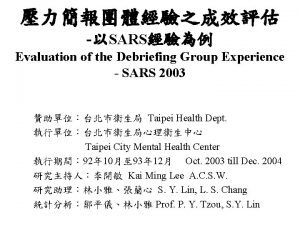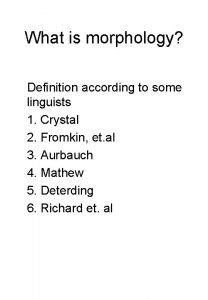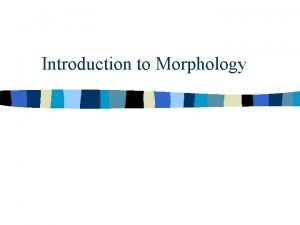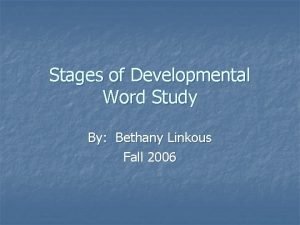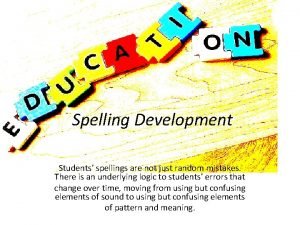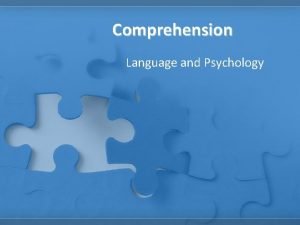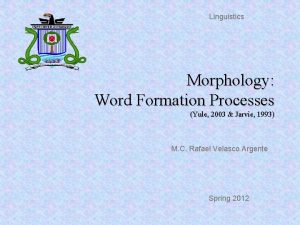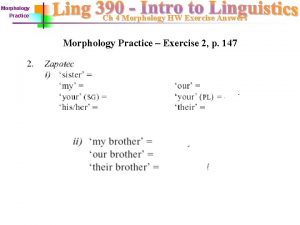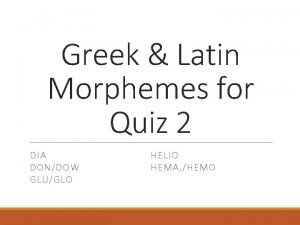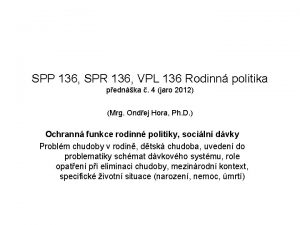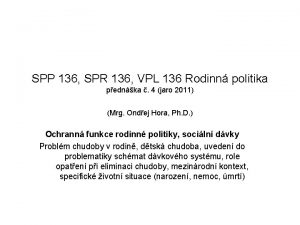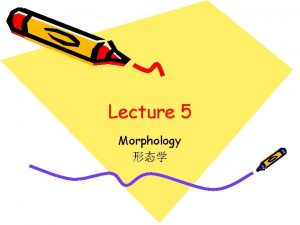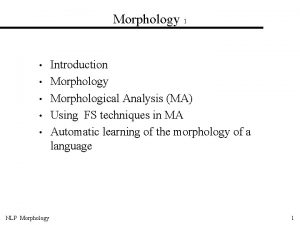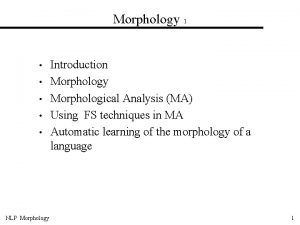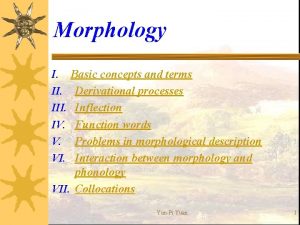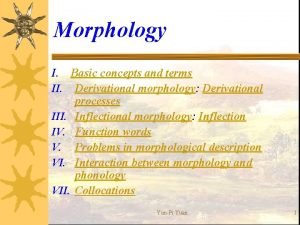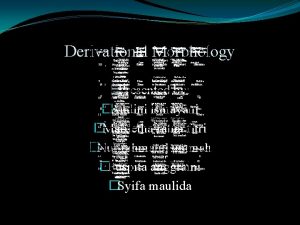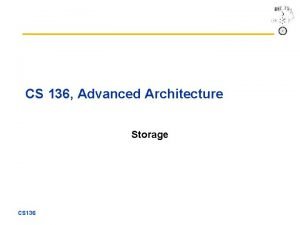Morphology Cont Functions pg 136 7 Clark Derivational









![Allomorphy • [s] • [z] • [´z] Allomorphy • [s] • [z] • [´z]](https://slidetodoc.com/presentation_image_h/e7281104f81012f9cb4a32ae7bc869f0/image-10.jpg)
















- Slides: 26

Morphology Cont

Functions pg 136 -7 Clark • Derivational – Morphemes that alter the meaning – In English prefixes or suffixes • Inflectional – Grammatical relationship/information – In English all suffixes

Inflectional or Derivational? • • • The {-er} in “bigger” The {-ment} in “judgment” The {un-} in “unkind” The {-ing} in “walking” The {-er} in “golfer” The {-en} in “darken”

Hierarchy • Words are formed in steps • When more than one affix = more than one step • Represent hierarchical structure with “trees” – Shows steps

Trees • Un. think. able – Think thinkable unthinkable A A un think able

Ambiguity • What does unlockable mean? – Meaning 1: capable of being unlocked – Meaning 2: can’t be locked • {un-1} A A (‘not’) – Unhappy, unthinkable • {un-2} V V (reverse the action of V) – Untie, undo, unscrew

A closer look at ambiguity A A V un- A lock can be unlocked -able un- lock -able cannot be locked

Allomorphy • English Plural • Written two ways – “cats”, “dogs”, “bicycles”, “wars” – “bushes”, “walruses”, “watches” • Pronounced three ways – [s] – [z] – [´z]

Allomorphy • • “cows” “flamingos” “toads” “partridges” “snakes” “ostriches” “giraffes” “apes”
![Allomorphy s z z Allomorphy • [s] • [z] • [´z]](https://slidetodoc.com/presentation_image_h/e7281104f81012f9cb4a32ae7bc869f0/image-10.jpg)
Allomorphy • [s] • [z] • [´z]

Allomorphy /z/ {-z} {-s} {´z} • z s / voiceless consonant __ • z ´z / frication __ • z z / elsewhere

How to do a morphology problem – Examine your data • Don’t be confused by unfamiliar symbols. You are looking for patterns in form and meaning. – Choose two similar items • Maybe they differ by only one or two symbols – Check the glosses for those items • The glosses for those similar items will differ slightly (perhaps in tense or subject). – Make a hypothesis • Hypothesize as to the difference in form and its relationship to the difference in meaning. – Test your hypothesis • Use other data to confirm or reject your hypothesis

Kanuri (a language spoken in Western Africa) gana kurugu numkura numgana numkurugu “small” “big” “long” “bigness” “smallness” “length” First, examine your data…

Choose two similar items gana kurugu numkura numgana numkurugu

Check the glosses for those items gana kurugu numkura numgana numkurugu “big” “bigness” Can you make a hypothesis based on this pair of words?

Test your hypothesis gana kurugu numkura numgana numkurugu “small” “big” “long” “bigness” “smallness” “length”

Conclusion

Hanunoo (a language spoken in the Philippines) usahi duwahi upati unumi “one” “make it one!” “two” “make it two!” “four” “make it four!” “six” “make it six!”

Choose two similar items ‘usahi duwahi ‘upati ‘unumi

Check the glosses for those items ‘usahi duwahi ‘upati ‘unumi “two” “make it two!” Can you make a hypothesis? ?

Test your hypothesis ‘usahi duwahi ‘upati ‘unumi “one” “make it one!” “two” “make it two!” “four” “make it four!” “six” “make it six!”

Make a new hypothesis and test it ‘usahi duwahi ‘upati ‘unumi “one” “make it one!” “two” “make it two!” “four” “make it four!” “six” “make it six!”

Conclusion

Arabic fasara fassara thakkara bala’a balla’a “she/he discovered” “she/he explained” “she/he remembered” “she/he reminded” “she/he reached” “she/he brought”

Conclusion • Infix – reduplicate C 2 – “causative” action is shifted from doer to receiver

Homework • Due Monday 9/27
 Inflectional morpheme
Inflectional morpheme Cont or cont'd
Cont or cont'd Cont or cont'd
Cont or cont'd Functions of marketing by clark and clark
Functions of marketing by clark and clark Total suppletion examples
Total suppletion examples Morphology definition linguistics examples
Morphology definition linguistics examples Derivational morphology
Derivational morphology Inflectional infix
Inflectional infix Whats a compoud word
Whats a compoud word Derivational relations stage
Derivational relations stage Derivational affixes
Derivational affixes Derivational base
Derivational base Derivational relations stage
Derivational relations stage Plural morpheme
Plural morpheme English morphology exercises
English morphology exercises Derivational relations stage
Derivational relations stage Examples of words with 5 morphemes
Examples of words with 5 morphemes Derivational base
Derivational base Inflectional or derivational
Inflectional or derivational Semantic primes
Semantic primes Derivational and inflectional morphemes
Derivational and inflectional morphemes Bathtub effect in psycholinguistics
Bathtub effect in psycholinguistics Derivational relations stage
Derivational relations stage Proloferated
Proloferated Derivational thinking
Derivational thinking English morphology practice with answer
English morphology practice with answer Hemo greek
Hemo greek

